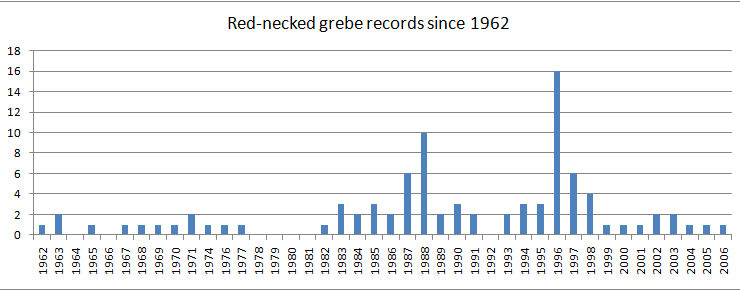Tachybaptus ruficollis
Breeding resident and winter visitor.
The Little Grebe breeds throughout the temperate and tropical Old World and is resident, dispersive and migratory.
In Pembrokeshire it inhabits still fresh waters in the breeding season so is absent from the fast flowing rivers and streams. It requires waters to be vegetated around the fringes and beneath the surface. It is secretive and inconspicuous around the breeding area and can easily be overlooked, its far carrying, distinctive, whinnying call often being the first indication of its presence.
The breeding status of this species in the county in the past is difficult to evaluate. To Mathew (1894) it was a breeding species but by 1949 Lockley et al stated “apparently does not breed”.
Saunders (1976) commented “Strangely it does not remain to breed, for at least to human eyes, there are several suitable waters.”
However, Bertram Lloyd’s diaries contain records of breeding at Llambed in 1936 and suspected breeding at Slebech in 1937 and Sharrock (1976) indicated possible breeding between 1968 and 1972 in the south west of the county.
Donovan and Rees (1994) quoted breeding at Thornton Reservoir (now defunct) in 1965, at Pembroke Mill Pond in 1975 and at Trefloyne in 1981, with suspected breeding at Bosherston during the 1970’s and 1980’s.
The lack of breeding during the review periods of Lockley et al and Saunders might well have been the result of severe winters in 1939-40, 1947-48 and 1962-63 eliminating a small population which was previously present.
Two breeding bird surveys of the county using a grid of tetrads have since been completed and the results are summarised as follows:
[Breeding maps & statistics]
Comparison of the results of the two surveys indicates an almost fourfold increase in the number of occupied tetrads during the elapsed period. Most birds were on well vegetated farm ponds used for irrigation. Many of the ponds used in 2003 – 07 had only recently been constructed in the 1980’s and only subsequently became vegetated and thus suitable for Little Grebes.
Although most small waters were used by just one breeding pair, some tetrads encompassed more than one such body of water and on some larger waters there was more than one pair, for instance there were four pairs at Marloes Mere. Allowing for these variables, the county total was estimated to be about 70 pairs by 2007, compared to 12 pairs in 1988.
Graham Rees
(Covers records up to and including 2008)
References
DONOVAN. J and REES. G. 1994. Birds of Pembrokeshire, Dyfed Wildlife Trust.
LLOYD. B. 1929-1939 Diaries, National Museum of Wales.
LOCKLEY. R. M, INGRAM. C. S. and SALMON. H. M.1949. The birds of Pembrokeshire, West Wales Field Society.
MATHEW. M. 1894. The birds of Pembrokeshire and its islands, R. H. Porter.
SAUNDERS. D. R. 1976. A brief guide to the birds of Pembrokeshire, Five Arches Press.
SHARROCK. J.T. R. 1976. The atlas of breeding birds in Britain and Ireland, Berkhamsted, T. & A. D. Poyser.
 Thursday, August 18, 2011 at 11:49PM
Thursday, August 18, 2011 at 11:49PM  GHR,
GHR,  grebe,
grebe,  oil spill,
oil spill,  waterbird in
waterbird in  Little Grebe
Little Grebe 





